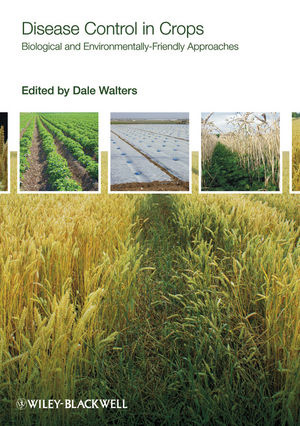Disease Control in Crops: Biological and Environmentally-Friendly ApproachesISBN: 978-1-4051-6947-9
Hardcover
280 pages
April 2009, Wiley-Blackwell
 This is a Print-on-Demand title. It will be printed specifically to fill your order. Please allow an additional 15-20 days delivery time. The book is not returnable.
|
||||||
Preface
Chapter 1 Introduction
Dale Walters
1.1 The importance of plant disease
1.2 Problems associated with controlling plant disease
1.3 Conclusions
1.4 Acknowledgements
1.5 References
Chapter 2 Managing crop disease through cultural practices
Dale Walters
2.1 Introduction
2.2 Reducing the amount of pathogen inoculum
2.3 Reducing pathogen spread within the crop
2.4 Soil amendments and mulching
2.5 Suppressive soils
2.6 Intercropping
2.7 Conclusions
2.8 Acknowledgements
2.9 References
Chapter 3 Biological control agents in plant disease control
John M. Whipps and Mark P. McQuilken
3.1 Introduction
3.2 Modes of action
3.3 Production, formulation and application
3.4 Commercial products available and uses
3.5 Factors affecting variable efficacy and constraints on commercial developments
3.6 Future research directions and conclusions
3.7 References
Chapter 4 Induced resistance for plant disease control
Tony Reglinski and Dale Walters
4.1 Introduction
4.2 Induced resistance in practice
4.3 Costs associated with induced resistance
4.4 Trade-offs associated with induced resistance
4.5 Future prospects
4.6 Acknowledgements
4.7 References
Chapter 5 The use of composts and compost extracts in plant disease control
Audrey Litterick and Martin Wood
5.1 Introduction
5.2 Definitions of composts, composting, compost extracts and compost teas
5.3 Production of composts and compost extracts/teas
5.4 History of the use of composts and compost extracts in crop production
5.5 Current use of composts and compost extracts/teas in crop production
5.6 Crop and soil health
5.7 Effects of composts on plant disease
5.8 Effects of compost extracts/teas on plant disease
5.9 Mechanisms involved in the suppression/control of plant disease using composts and compost extracts/teas
5.10 Conclusions and future work
5.11 References
Chapter 6 The use of host plant resistance in disease control
Hugh Wallwork
6.1 Introduction and benefits of resistance
6.2 Types of resistance
6.3 Sources of resistance
6.4 Breeding methodology and selection strategies for inbreeding crops
6.5 Deployment of resistance
6.6 Conclusion
6.7 References
Chapter 7 Crop tolerance of foliar pathogens: possible mechanisms and potential for exploitation
Ian Bingham and Adrian Newton
7.1 Introduction
7.2 Concepts and definitions – a historical perspective
7.3 Yield formation
7.4 How can tolerance be quantified?
7.5 Potential crop traits conferring tolerance
7.6 Is there a physiological or ecological cost to tolerance?
7.7 Role of modelling
7.8 Strategy for improving tolerance
7.9 Acknowledgements
7.10 References
Chapter 8 Plant disease control through the use of variety mixtures
Adrian Newton
8.1 Introduction
8.2 Trial demonstrations of mixtures
8.3 Mixtures used in practice
8.4 Conclusion
8.5 References
Chapter 9 Biofumigation for plant disease control – from the fundamentals to the farming system
John Kirkegaard
9.1 Introduction
9.2 The glucosinolate–myrosinase system
9.3 Modes of utilization
9.4 Separating GSL-related suppression from other effects of biofumigants
9.5 Maximizing biofumigation potential
9.6 Release efficiency, fate and activity of hydrolysis products in soil
9.7 Ecological considerations
9.8 Field implementation
9.9 Summary
9.10 References
Chapter 10 Control of plant disease through soil solarization
Abraham Gamliel and Jaacov Katan
10.1 Introduction
10.2 Principles of soil solarization
10.3 Pathogen and weed control
10.4 Mechanisms of control and plant-growth improvement
10.5 Integrated management
10.6 Modelling of soil solarization and decision-making tools
10.7 Improvements by intensifying soil heating
10.8 Implementation and application
10.9 Special uses of solarization
10.10 Solarization and the MB crisis
10.11 Concluding remarks
10.12 References
Chapter 11 Plant disease control by nutrient management: sulphur
Silvia Haneklaus, Elke Bloem and Ewald Schnug
11.1 Introduction
11.2 Sulphur-induced resistance – agronomic, physiological and molecular aspects
11.3 Perspectives in research
11.4 References
Chapter 12 Control of plant disease by disguising the leaf surface
Dale Walters
12.1 Introduction
12.2 Controlling disease using film-forming polymers
12.3 Particle films as agents for control of plant diseases
12.4 Disrupting spore adhesion to the leaf surface
12.5 Conclusions
12.6 Acknowledgements
12.7 References
Chapter 13 Bacteriophages as agents for the control of plant pathogenic bacteria
Botond Balogh, Timur Momol, Aleksa Obradovic and Jeffrey Jones
13.1 Introduction – disease control for bacterial diseases
13.2 Biological control
13.3 Early use of bacteriophages in agriculture
13.4 Recent approaches for using phages in plant pathology
13.5 Challenges in using phages for disease control
13.6 Phages as part of an integrated management strategy
13.7 Summary
13.8 References
Chapter 14 Controlling plant disease using biological and environmentally friendly approaches: making it work in practice
Dale Walters
14.1 Introduction
14.2 How might biologically based disease control be used in crop protection practice?
14.3 Biologically based disease control: barriers to implementation
14.4 Conclusions
14.5 Acknowledgements
14.6 References
Index



